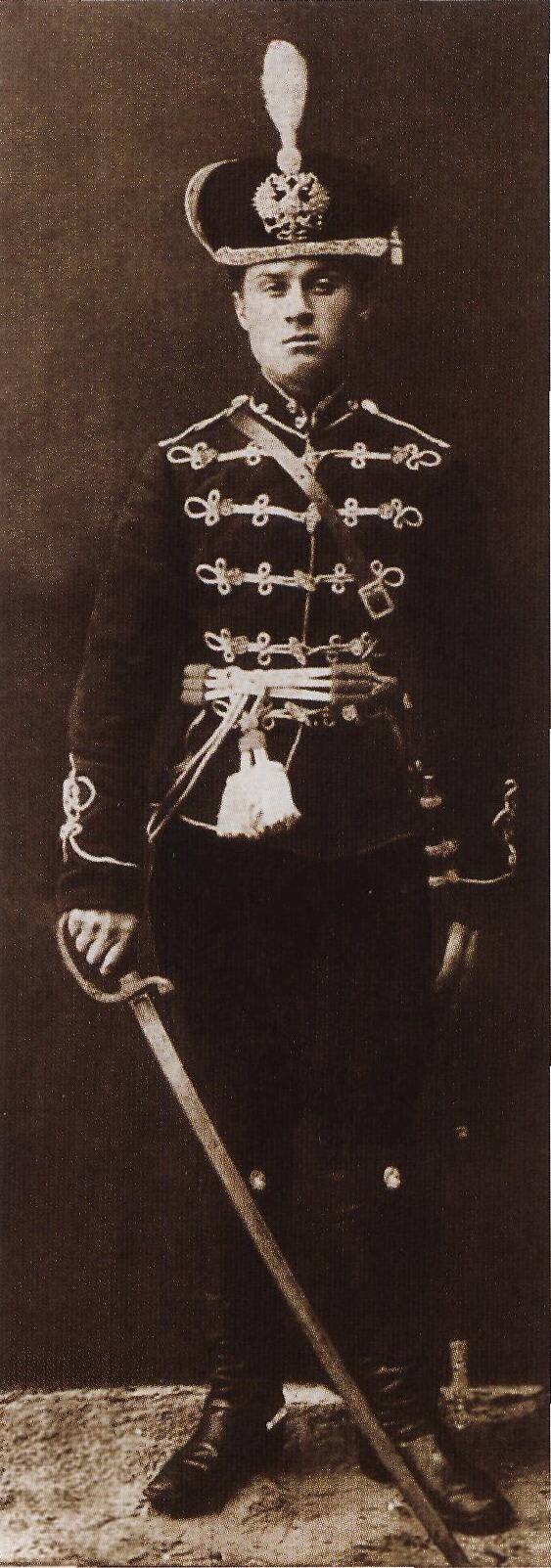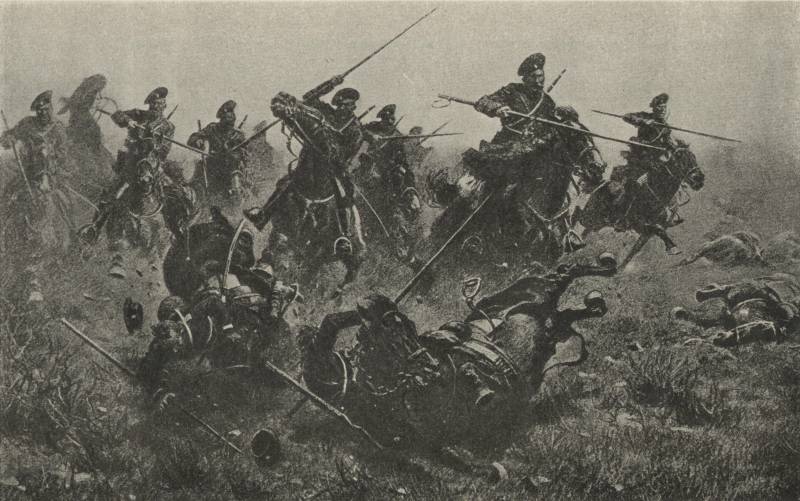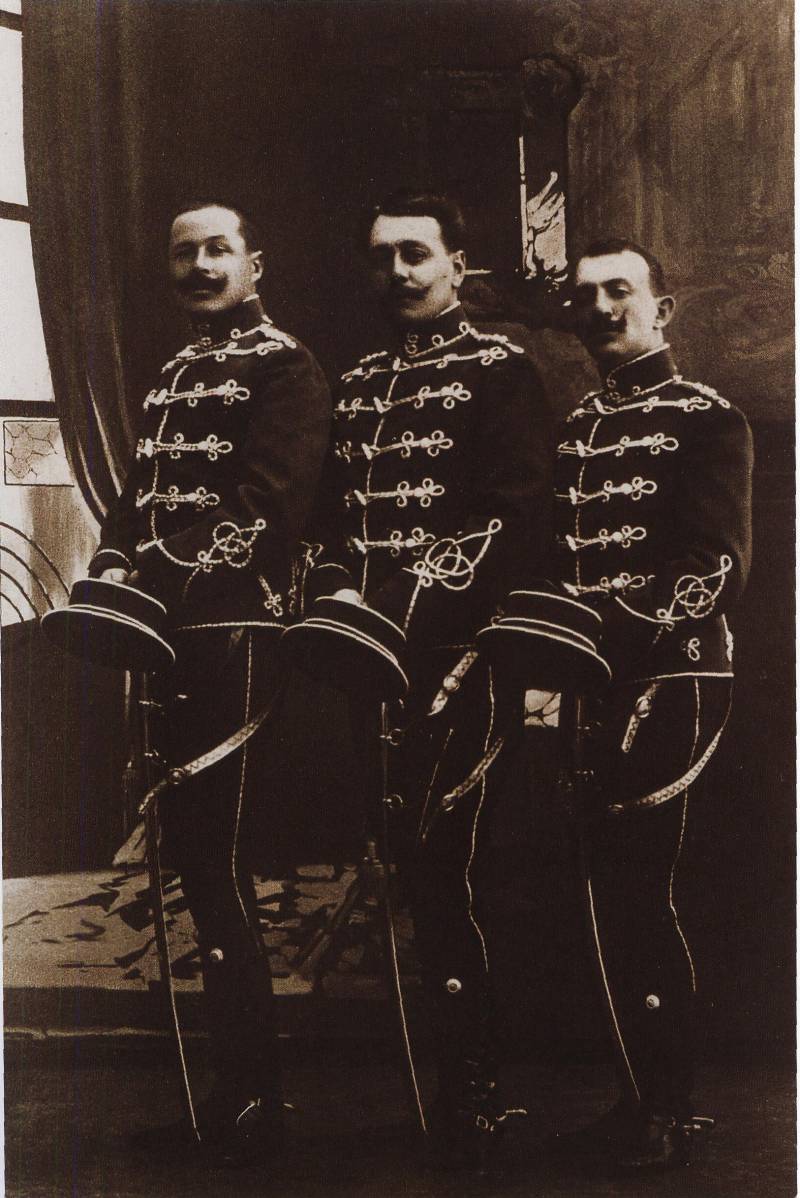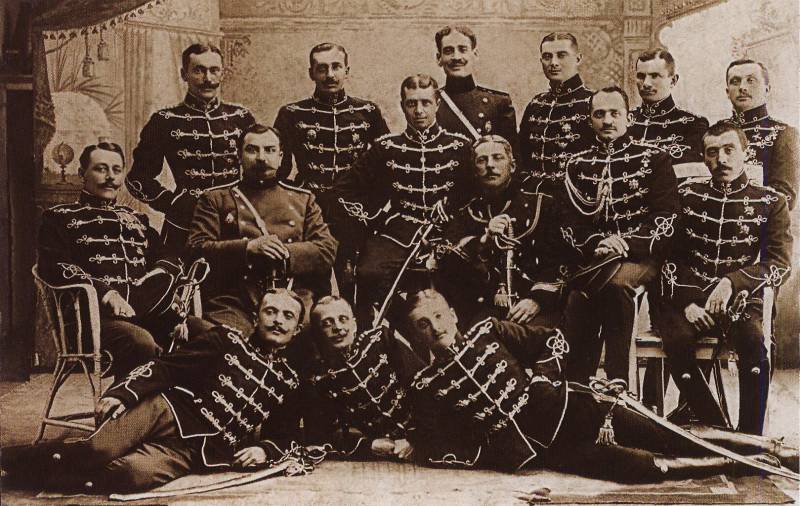Neradovo. History of horse attack operational value. 2 part
An eyewitness recalled how groups of horses suddenly appeared from behind the farm - as if without riders, and their number increased exponentially. And then the Germans remembered East Prussia, where he had already met the Cossacks, and he shouted that it was the Cossacks that the equestrian attack began. There were shouts from all sides: “Fire!”, “They hang on the sides of their horses!”, “Hold on!”. All who could keep weapon (including the wounded) opened fire - standing, lying down, from the knee. Machine guns also opened fire, showered the attacking cavalrymen with a hail of bullets.
Horsemen appeared in close formations, and, having scattered "as the unleashed sheaf", rushed on infantry - Cossacks with peaks in hands, hussars with naked swords. A part of the cavalry turned on the Stavets farm. Two officers galloped ahead with high drafts, one on white and the other on a caracas horse. The German noted that "These details are still alive in my memory ...
behind us on a hillock stood reserves in close formations. They opened the fire over our heads, and part of the bullets, unfortunately, fell into our ranks. I still hear screams: “Fire! The fire! Rapid fire! ". Then the commands: “Lie down! Stand up! Take them on bayonets! .. ”. And everything at this time fired so that the barrels of rifles were heated ... ".
An eyewitness noted a field gallop of cavalry rushing by a hurricane, the “wild Sarmatian faces” of horsemen and the edge of the terrible peak. The Germans "possessed horror" and "hair stood on end." All they could do was shoot, trying to sell their lives at a higher price. The officers in vain gave the command "lie down" - the proximity of a terrible danger made everyone who still could jump to their feet.
“However, our hurricane fire mowed down the Russian cavalry rushing towards its death. ... Here and there, the high reared up and the horse overturned; having fallen under a machine-gun fire at close range, the horsemen fell or jumped from the wounded horses, the horses threw, fell, flew, enraged, not listening to the occasion, in different directions, bringing disorder into their own ranks. ” ...
Next to the author of these memories, a Cossack with a lance broke through his companions, and dragged him until he himself fell from a horse, hit by several bullets.
“Some have managed to make their way through our chain; they rode up to our reserves ... Part of the attacking cavalry broke through the Scety folvark, then turning west, towards Schwelitz ...
Cossacks and hussars sacrificed themselves in the name of saving their ... infantry .... On this day, we were filled with respect for the Russian cavalry ”[Beckman V. The Germans about the Russian army. Prague. 1939. C. 19-21].
6. Cossack attack.
The Combat 229 of the reserve infantry regiment also noted: “And now my blood is still cold in my veins when the spectacle of the cavalry that has doomed itself to death is rising in my memory. As in the arena, this attack unfolded before my eyes for barely more than two minutes ”[Ibid. C.21].
The Russian eyewitness, in turn, recalled how many corpses of cavalrymen and infantrymen remained to lie on the fields of non-Radovsk. He recalled a lying Cossack with a face covered with blood and a horse with a broken leg standing next to him - the Cossack holds a reason in his hand, and the horse stands with its head hanging, slipping it to the owner, as if wanting to plant it in the saddle. There is a mass of Germans with terrible wounds from drafts and rush. For many dead people, the peaks are not pulled out - and the infantrymen squeeze them with dead fingers.
After the battle, the brigade gathered at the forest, from where the attack began. This was due to the fact that the Germans, who surrendered to captivity, were not timely disarmed and evacuated to the rear - they were met with fire by returning back groups of cavalrymen who could not break through to the village. Schwelice Therefore, it was not possible to carry out the corpse of A.I. Westfalen, who fell at the high fence of the Neradov court - the Germans who defended the yard were also not disarmed, and in order to return the body of the colonel, it was necessary to storm this fatal yard again, but now it wasn’t forces Many cavalrymen returned on foot, and some of them caught horses and sat in the saddle again, picked up the wounded.
The key factor in the non-Radov battle was that the cavalry attack was a complete surprise to the German infantry - and its three lines (chains and closest support) were virtually destroyed. The fact that the Germans were stunned was evidenced by the fact that they threw rifles in masses, raising their hands up. But the second and especially the third lines met the cavalry with strong rifle-and-machine-gun fire, including from the der. Neradovo. The cavalrymen had to fight an unusual battle for them for the locality - firstly, this knocked down the pace of the attack, and secondly, it was during this period that the brigade suffered the main losses. However, during the battle, the attacking Russian cavalry reached the enemy's artillery positions. The enemy lost three settlements - the villages of Nayevo-Velkoy and Nayevo-Tsyta were abandoned, and the village of Neradovo was captured by the Russians in battle. Powerful frontal and flank fire eventually forced the brigade to split up and then turn back - the loss of cavalry reached 50% of the squadron (and the squadrons attacking in the first line lost up to 80%).
But the enemy was so stunned that he did not pursue the retreating cavalrymen even with fire. The lack of reserves did not allow to finish off the bewildered enemy, but the Germans ’offensive pace slowed down sharply, and the actions of the German infantry subsequently became extremely cautious. In this situation, the infantrymen and the Siberian and Turkestan arrows cheered and counterattacked the enemy. The success of the cavalry helped the battalions of the 30 Infantry Division and the 7 and 8 of the Turkestan rifle regiments to organize a departure to the borders of the Godachi - Vypikhi - Lukovo villages - the infantry was able to systematically withdraw, avoid enemy pursuit and remove all the wounded from the battlefield (and only Turkish troops). lost 3 July a total of 450 people).
"Brief description of the 14-th Don Cossack Military Ataman Efremov regiment's operations from the 19-July July 1914 to 1 December 1915" [РГВИА. F. 2007. Op. 1. D. 42. C. 2] gives the following laconic description of these events: “July 3 1915 in the resulting breakthrough between the Turkestan and Siberian corps, the Germans launched an energetic offensive. To the rescue of the infantry, the regiment as part of the 2 Brigade of the 14 Cavalry Division launched a cavalry attack on the advancing German infantry in the area of d. Neradov-Kolachkovo. The attack was carried out under extremely unfavorable conditions - a completely open area for 6 versts, crossed by drainage ditches, covered with thick high rye, under heavy artillery, rifle and machine-gun fire, with heavy rain and wind. ... After the attack, the Germans completely stopped the offensive on the entire combat front. ”
It should be noted that, under Neradov, the Russian cavalry overturned not the demoralized, retreating or enemy infantry on the march, but the German division advancing in deployed combat formations and inspired by the recent success — that is, a powerful combat unit with full support of machine guns and artillery — the 50-y-yax (229, 230 and 231 reserve infantry regiments). Of the registered 700 wounded and 100 killed in the battle of 3 on July 4th, the fighters of this compound were out of action during the cavalry attack.
Under the Neradov, the Hussars of Matavia earned a very prestigious collective battle award - the St. George Standard, but they lost the hero-commander. The hussar regiment lost 9 officers (including the commander) killed and 13 wounded, Cossack - 2 officers killed, 1 went missing, 2 were injured and then captured, 2 was injured. 250 Hussars and 161 Cossacks were killed and wounded.
The brigade received thanks from the commander of the 1 Army General of the cavalry A. I. Litvinov, the Supreme Commander (Nikolai Nikolayevich called the battle of Neradov "attack, resurrected the old precepts of the Russian cavalry") and the highest gratitude. A.I. Westfalen was posthumously awarded the Order of St. George of the 4 degree and promoted to major general. Lieutenant Colonel A. A. Surazhevsky, Lieutenant Genisht 1 was presented to the Order of St. George 4, and the staff captain Pyshnev and captain Kartavtsev and Shpilev - to the St. George's Weapon.
In the 14 Don Cossack Regiment, the commander of the Order of St. George of the 4 degree was his commander, Colonel A. A. Karneyev. Five officers (military foremen L.T. Bykadorov and L.T. Razdorov, the esaules I.F. Rykovsky and I.A. Farafonov, podseaul S.I. Yakushev) received the St. George Weapon. The 30 Cossacks were awarded St. George Crosses and the 30 Cossacks were awarded St. George medals. And the overwhelming majority of the military awards of the officers of the regiment during the World War - for the battle of 3 July 1915.
"Description of the exploits of officers of the 14-th Don Cossack Military Ataman Efremov Regiment, awarded from the beginning of the war on 1-January 1917, the Order of St. George and the St. George weapon" [RGVIA. Ibid.] Describes the exploits of Cossack officers as follows.
Awarded the Order of St. George 4 degree Karneyev Alexander Alexandrovich. Because 3 July 1915, in a battle with the Germans in the area d.d. Neradovo-Lukovo, when the German infantry brigade moved into the gap between the Siberian and 1 Turkestan army corps, threatening the final breakthrough of the military disposition of these corps, which put a special situation on the right flank of the Turkestan Corps 1 in the Turkestan Corps in the right flank 1. rifle regiment, - Colonel Karneev, personally commanding his regiment, in his head rushed to the attack on the German infantry and, sacrificing himself, passed through three lines of German chains under the strongest machine gun nym and rifle fire of the enemy, and hacked and perekoloto was a lot of Germans, after this the most offensive of the enemy stopped its artillery was quickly taken away, and the intended dangerous opponent for us a breakthrough in the joints of the two buildings was paralyzed.
Awarded the St. George Arms.
Former commander 6 th hundreds Esaul (now Colonel) Rykovsky Ivan Fedorovich. For the fact that 3 July 1915, when significant German forces broke through our location near the village of Kolachkovo, they began to spread in the resulting breakthrough between the corps (Turkestan and Siberian), strongly attacking our infantry, 2 th Brigade 14 Cavalry the division was ordered to launch a horse attack in order to halt the German offensive. Esaul Rykovsky, despite the hurricane fire at a distance of five miles away on a completely open area, commanding his hundred, personal example of courage, brought the enemy, got into it and made confusion among the German infantry; this further stopped the enemy’s offensive and our infantry calmly withdrew and took the position indicated for the defense.
Former commander 2-th hundreds Esaul (now the Colonel) Farafonov Ilya Andreevich. ... Pharafonov, commanding two hundred reserves, despite the hurricane artillery and machine-gun fire, at a distance of more than five miles away, in a completely open area, crossed by several drainage canals, personally leading the division, cut into the enemy’s chains and, having passed three lines, made them confused ...
Leonid Trofimovich, commander of the 4 of the hundreds of Military Chief of Staff Sergeant Razdorov. ... Razgory ... commanding his hundred, brought it to contact with the enemy, got into it and passed the three lines of the German infantry, the goal was achieved ...
Bykadorov Ivan Fedorovich. ... commanding two hundred first lines, despite the devastating artillery and machine-gun fire ... brought their first line units to the enemy, got into it and, having passed three lines of German infantry, made confusion among them ...
Former commander of the 2 hundredth Podyesaul Yakushev Stepan Ivanovich. ... The commander of 2, hundreds of Podyazeul Yakushev, inspiring the Cossacks with the example of composure and courage, under a murderous machine-gun and rifle fire, going at the head of his hundred ... bravely cut into the ranks of the Germans, passing three rows of German field trenches, where he was wounded and died battlefield After the attack, the German offensive was suspended and parts of the Turkestan and Siberian corps were given the opportunity to freely withdraw and take the positions indicated by them.
The Russian cavalry at Neradov was solved the most important operational and strategic task.
The northern group of German troops, Galvitsa, who attempted to reach Pułtusk and the bridges across the Narew, could not connect with the southern group of Austro-German troops advancing on Lublin-Kholm. Not least due to the actions of the brigade of the 14 Cavalry Division. Russian troops on the left bank of the Vistula were in danger of being surrounded - and the sacrificial feat of the Lithuanian hussars and Don ataman Efremov Cossacks allowed the Russian command to delay the enemy’s attack, transfer reserves and give their infantry a breather.
The breakthrough that threatened the 1 Army with serious troubles was localized - and the enemy halted a victorious offensive at the junction of the corps, which allowed the infantry to clean up. Moreover, the German offensive, which had resumed only at night, was more restrained, and artillery fire, which had become much weaker, was fought now from more distant distances.
Thus, a bold maneuver of the heroic brigade saved the army, parrying a promising breakthrough of the Germans. The offensive of the German infantry was delayed by five hours - and the precious time was bought by the blood of the Russian cavalry.

7. Hussar 14-th Mitavskogo regiment in full uniform.
8. A group of chief officers of the 14 Hussars of the Mitava Regiment in full uniform.
9. The officers of the 14 th hussar Mitavskogo regiment. 1913, city of Czestochowa. From left to right are: Tinkov, Bronikovsky, Abrumyants, Petrovsky, Korolev, Obidzitsky. Sit: Kartavtsev, Sokolov, Pyshnev, Pushkin (in Uhlan form), Sonin, Samilovich. First row: Voronin, Voitekunas, Akare.



Information